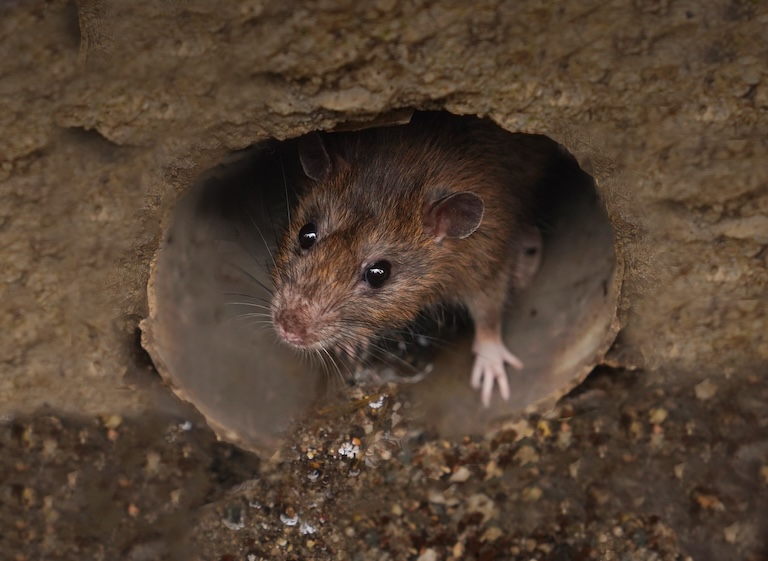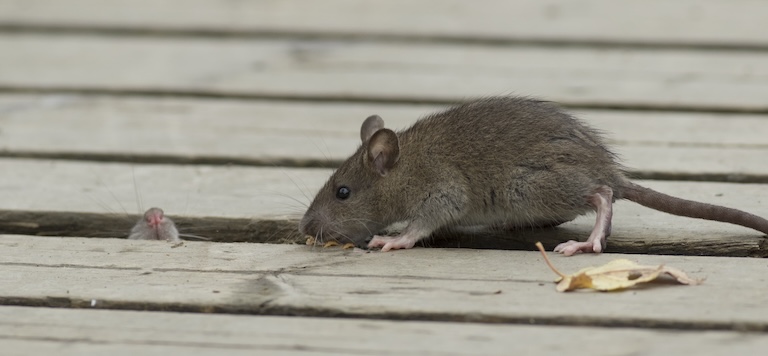Rat Profile
Rats of the genus Rattus are known as the ‘true rats’, which have the usual features associated with rats. 1
They have extensive, mostly hairless tails that are usually as long as the body, pointed faces with lengthy whiskers and large ears sitting on top of their head. Species in this genus are found on every continent except for Antarctica and have proven themselves to be very adaptable to human disturbance.
Though they do carry some diseases and are often seen as a pest, rats are an invaluable part of the ecosystem when their numbers are kept in check.
The Rattus genus consists of over 60 different species, with some new species still being discovered. Most of these species are shades of brown or black and are omnivorous, feeding on a variety of food, including other animals.
They are found across a range of habitats, from dense tropical forests to semi-arid deserts. Some species are shy and live away from human habitation, while others can be found living indoors in houses, factories and most other man-made structures.

Rat populations can sometimes reach epidemic proportions due to their ability to breed prolifically. However where natural predators still exist, they form an important part of the food chain. They are the ultimate survivalists, often able to sense danger and adjust accordingly.
Although rats will eat almost anything edible, their excellent sense of smell and high level of intelligence means they are able to choose the most nutritious food available, sustaining themselves through periods where food availability is low.
As well as those rats that live a completely wild existence, rats have also become an integral part of human life. Rats have been domesticated for hundreds of years, kept as pets and used as food for other animals or as prey for hunting animals.
Tame rats, known as ‘fancy’ rats, are known to be highly intelligent, show interesting behaviours and can be very affectionate. For many years rats have been used in laboratories as test subjects, often testing medicines which eventually are used in humans. 2
Rat Facts Overview
| Habitat: | Almost every habitat type, including human dwellings |
| Location: | All continents except Antarctica |
| Lifespan: | Up to 2 years in the wild |
| Size: | Average 30cm from nose to tip of tail |
| Weight: | Up to 500g |
| Colour/Appearance: | Usually shades of yellow, brown or black with a lighter underbelly. Typical rat, with large ears, short fur, pointed snout, lengthy whiskers and a long, hairless tail. |
| Diet: | Omnivorous, feeding on a huge range of food items. Most prefer meat where available |
| Predators: | Carnivorous mammals, reptiles, raptors and domestic cats and dogs |
| Top Speed: | Up to 18km/h |
| Number of Species: | Over 60 |
| Threats: | Poisoning and habitat loss |
| Conservation status: | Most species are considered Least Concern but some species Endangered |
Perhaps the most well-known rat species is the Norwegian brown rat, Rattus norvegicus. They are thought to have originated in China but travelled on ships and colonised other parts of the world. Although they are native to forested areas, these days they are more commonly found in and around human dwellings. 3
It is from this species that almost all tamed rats originate. These are the rats kept as pets and used in scientific research. They are also very famous for spreading the Black Plague which killed millions of people. Scientists now suggest however, that it is more likely that humans played a greater role in the spread of this disease. 4

A similar species to the brown rat is the black rat, Rattus rattus. Though similar to the brown rat in appearance, the black rat is smaller and darker and much less likely to be seen around humans. They are difficult to tame and thus not used in research. Unlike the brown rat, they rarely spend time near water and only swim when unavoidable.
On the other hand, the brown rat prefers to live near waterways and is an excellent swimmer. The black rat is sometimes called the ship rat and like the brown rat, this species was also unintentionally transported to new countries on ships.
Other species in this genus live a far more wild existence and thus are relatively poorly studied. The Turkestan rat for example lives in mountainous regions in Asia at altitudes up to 4,000m, whereas the nonsense rat of India, is found only on a few small islands and prefers tropical, dense forests.
Some species such as the ricefield rat eat insects in and around cultivated fields and are themselves eaten as food by people. Another interesting species is the summit rat, which eats nectar from a specific pitcher plant. In return the rat defecates into the pitcher plant, providing the plant with vital nutrients to continue growing. 5
Despite their persecution by humans, most rats have proven to be extremely successful in inhabiting areas where other animals cannot. This is largely due to the extraordinary intelligence that these rodents possess.
Researchers have found they can navigate mazes with ease, show empathy to weaker family members and can learn new tasks quickly. Rats often exploit loopholes in problems they face, many of which humans do not consider. Although extremely misunderstood, rats frequently keep insect numbers down as well as removing waste which would otherwise cause a health issue itself.
Interesting Rat Facts
1. Rats are still eaten in many countries
Due their abundance and their high protein meat, people still regularly eat rat meat.

2. Some rats are worshipped
In the Karni Mata temple in India, thousands of rats are fed and worshipped.
3. People who keep rats as pets often compare them to dogs
As they are highly intelligent, emotional and affectionate animals, pet rats resemble miniature dogs in many ways.
4. Rat teeth continue growing through their lives
Rats need to chew and gnaw in order to keep their incisor teeth from over growing.
5. A group of rats is called a ‘mischief’
Possibly due to their sneaky tendencies and interesting vocalisations, groups of rats often sound like they are up to mischief.
6. Rats time and again feature in stories and films
During the making of the Pixar ‘Ratatouille’, the people animating the films kept pet rats in the office to help understand them more thoroughly.
7. Rats were one of the first animals to be sent to space
France sent a specially trained rat called Hector into space in 1961.
8. They have incredibly strong teeth
It is no surprise that rats can be destructive, they can even chew through metal.
9. Rats have flexible spines
Rat vertebrae are designed so as to allow rats to fit through very tight spaces.
10. Rats are found everywhere, expect for Antarctica
The extreme cold conditions of Antarctica do not allow rats to survive, as they are warm-blooded like humans.
11. They have an exceptional sense of smell
Their sense of smell is so good that they can detect poison in food and can even be trained to detect land mines and drugs.
12. Brown rats are brilliant swimmers
Brown rats can swim very well, hold their breath underwater and even tread water for several days. 6

Rat Fact-File Summary
Scientific Classification
| Kingdom: | Animalia |
| Phylum: | Chordata |
| Class: | Mammalia |
| Order: | Rodentia |
| Family: | Muridae |
| Genus: | Rattus |
| Species: | Over 60 species |
Fact Sources & References
- “Rattus norvegicus”, Science Direct.
- “The Rat”, John Hopkins University.
- Alina Bradford (2023), “Rats: Facts about these thin-tailed, medium-size rodents”, Live Science.
- Author Name (Year), “Diet of the black rat (Rattus rattus) in a Canary laurel forest: species identification based on morphological markers and DNA sequences”, Taylor & Francis Online.
- “Rattus New Guinea rats”, Animal Diversity Web.
- Guy Musser (1999), “Rat”, Britannica.
